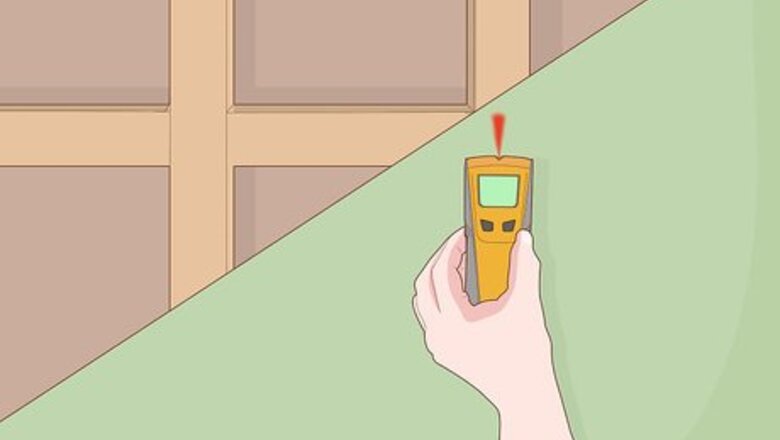
views
X
Research source
Living walls can be complete, self-sustaining ecosystems, but most often these take on simpler configurations, where hearty plants are grouped together in a wall hanging garden to make urban environments greener. By using a few handy tricks and techniques, your home could soon have a living wall of its own!
Choosing a Space for Your Living Wall
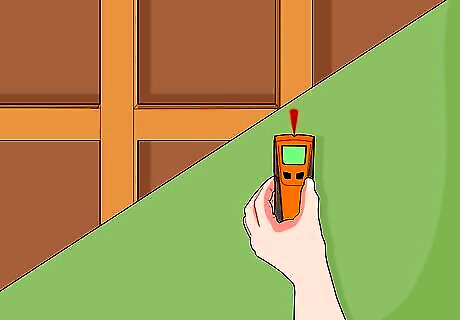
Evaluate placement options for outdoor and indoor living walls. You may already have an idea of where you want your living wall to be, but you should take into account other considerations, like the weight of your living wall, the amount of sunlight your wall gets throughout the day (and year), and removal or disposal concerns. Even if you're someone who has a green thumb, at some point one of your plants may need to be replaced. In this case, a living wall close to a door outside can prevent dirt or decayed plant matter from being tracked through your house. Take a stud finder and make sure your wall has weight bearing studs. Even the weight of a single plant with its roots saturated with water may be enough to pull your living wall free from wall anchors. Fastening your living wall firmly to two studs should prevent this. Imagine your living wall at different times of the year. For example, you may find that an outdoors living wall looks less desirable in the winter months if you live in a temperate climate. A living wall close to a large window might also be negatively impacted by cold during cold months.
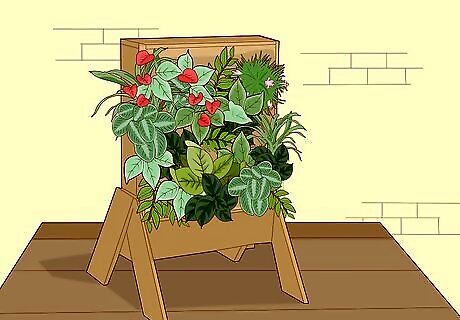
Decide on a pre-made kit or the DIY route. There are many companies that provide prefabricated wall-hanging frames in which you can plant your living wall. Some models are even freestanding, creating a kind of living wall partition in your home, which might be suitable if you do not have load bearing studs to fasten your living wall to. You can also fashion your own living wall simply enough with wood, plastic sheeting, and a plant friendly fabric.
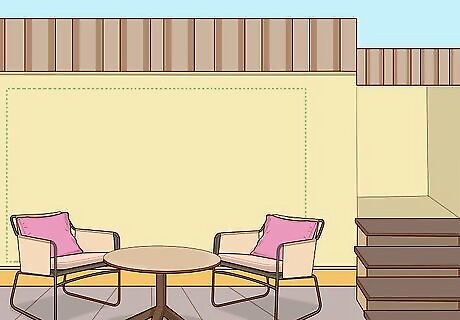
Measure and mark the space you wish your living wall to occupy. Use a pencil and a tape measure to mark the dimensions on the wall you intend your vertical garden to be and note these down. These measurements will be important whether you are buying a pre-made living wall or making your own. You might also want to mark the spot on the wall you've found studs. This way, when it comes time to hang your living wall, you can do so easily and without interruption.
Building a Living Wall from a Wooden Pallet
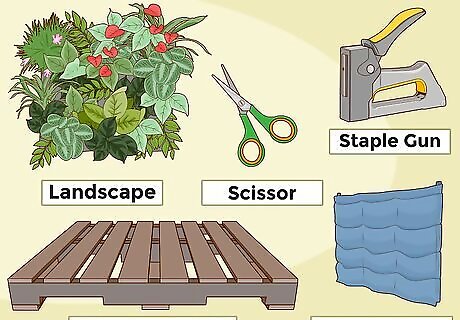
Gather your materials. You'll need some tools and supplies to construct your living wall on your own. In theory, most box shaped frames can be converted into a living wall, however, for the purposes of providing a guided example, a living wall built from a wooden pallet is used. To create your pallet wall you'll need: A wooden pallet Landscape material Plastic sheeting Pair of scissors Staple gun (and staples) Wooden pallets can be expensive, though these can often be found in the dumpsters of local businesses. You might even inquire with your local hardware as to whether there are extra pallets available for you to use for a personal project.
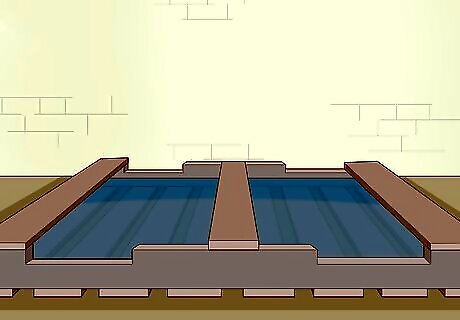
Layer the inside of your pallet with heavy plastic. Use your scissors to cut strips of plastic that fit the contours of the inside of your pallet. Lay these along the wood on the inside of your pallet and use your staple gun to firmly attach each strip in place. Be sure that every spot soil will be held is thoroughly protected with heavy plastic sheeting. In the event you don't have a staple gun, you can use tacks and a hammer instead. Make sure you use sturdy tacks that will stay firmly in place; a rupture in your plastic can lead to leakage that could damage your wall or dirty your floor. To ensure the health of your plants, you'll have to water your living wall regularly, which can cause the wood of your pallet to become compromised by rot or decay. Your plastic sheeting will prevent this from happening to the wood of your pallet.
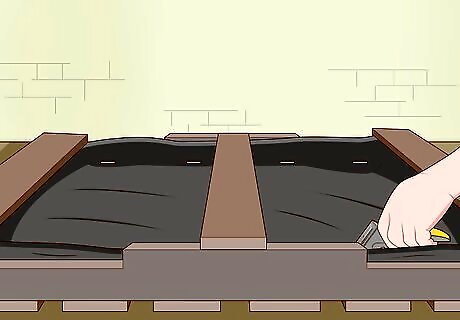
Line the inside of your pallet with landscape material. This often black textile will hold water and provide a moist environment for your plants to grow in. This will prevent the water from puddling in the crevices of the plastic, making it more available to your plants. Using your scissors, cut your landscape material in to strips same as you did for your heavy plastic, then attach the material in place with your staple gun or a hammer and tacks. The landscape material lining the inside of your plastic will help hold in moisture when you water your living wall. This will provide a healthy environment for the roots of your plants.
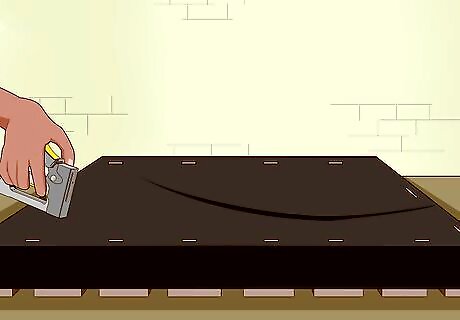
Seal off the back of your pallet. Now that the shelves of your living wall have been sealed and lined with plastic and plant friendly fabric, you'll need to close the back of the pallet, which would normally be its bottom if sitting on the ground. Cut a strip of landscape material with your scissors that extends the entire back of your pallet, and attach it with your staple gun around the outer rim of the pallet. Then do the same with your heavy plastic. You'll want to be sure that both your material and plastic are fastened to the back of the pallet as taut as possible. This will prevent leakage of water and dirt from the back of your living wall. You may want to consider using some kind of adhesive to guarantee a proper seal between the plastic and the back of your pallet. A general purpose, water resistant sealer, which should be available at your local hardware store, should work nicely.
Finishing Your Pallet Frame Living Wall
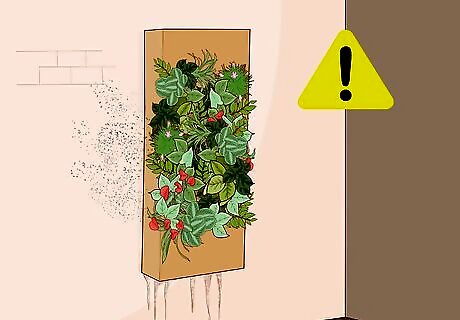
Test your design. If you've decided to build your own living wall, you may want to give it a test run before hanging it. Small mistakes in its lining can lead to dirt and water spreading to the load bearing wall your living wall is attached to. Prevent this by putting dirt in your wall before hanging and watering it. If leakage occurs, you may have to reline your living wall with plastic. You'll likely want to remove the dirt you used when testing before you actually install your living wall. The weight of the dirt can make it extra cumbersome when hanging.
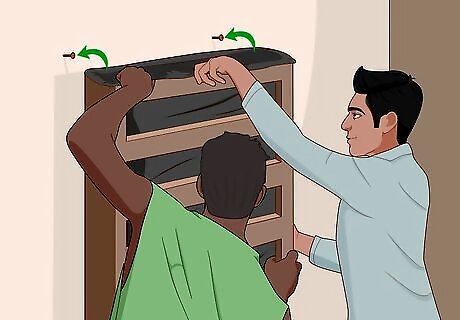
Install your living wall. Depending on the size and weight of your pallet, you may need a helper to efficiently and safely install your living wall. Hold the back of your living wall so that it aligns with the dimensions you have previously drawn on the wall. Use a level to check that it isn't crooked. Then: Use your screwdriver and several suitable screws to anchor your living wall to the studs behind it. The kind of screws suitable for your project will depend on the size of your living wall. A larger pallet will require a sturdier screw to hold it in place.
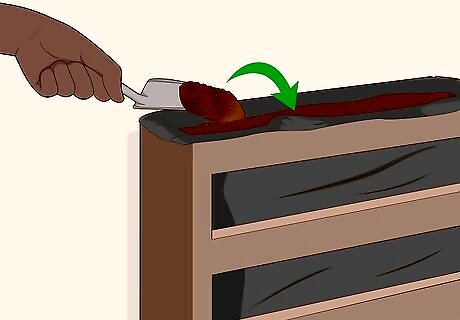
Add soil to your living wall. You should lay down a tarp or an old sheet to collect any dirt that falls on the floor. Take your potting soil and add it to the shelves/boxes of your new living wall. At this point you should also consider adding a controlled release fertilizer for your plants. Controlled release fertilizers offer nourishment to plants over time, reducing the amount of continued fertilizing you'll need to do. As these fertilizers vary considerably from brand to brand, you should follow the directions that come with it carefully. You may want to leave your sheet or tarp in place while adding plants to your living wall. However, if you intend on growing plants from seed, you should be fine removing your sheet or tarp, shaking the dirt on it free outside, and then putting it away.
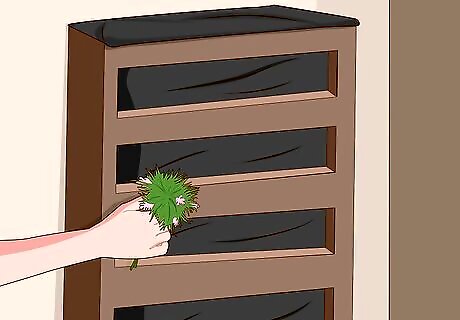
Insert plants, or try to grow some from seeds. What you grow is up to you! But to give you some ideas, some of the most successful plants used by wall growers include the lipstick plant (aeschynanthus radicans), the sword fern (nephrolepis exaltata), wedding vine (stephanotis floribunda), and wax flower (hoya Carnosa). You could create a mosaic looking living wall by growing succulents like Hens-and-Chicks (Sempervivum tectorum / Echeveria elegans), aloe, Panda Plants (Kalanchoe tomentosa), Christmas Cactus (Schlumbergera x buckleyi), and more. These will create a relatively low maintenance patchwork effect in your hanging garden. In mellower rooms, you may want to give a relaxed vibe. This can be accomplished with climbing and hanging vines. You might try Grape/Oakleaf Ivy, English Ivy, Philodendron, and Spider Plants.
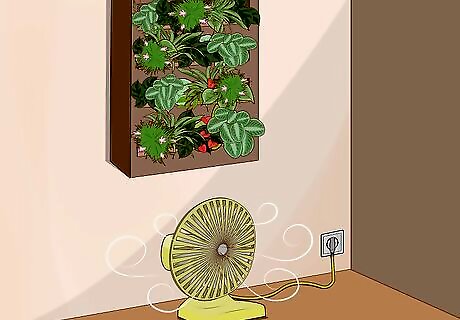
Improve circulation to receive the benefits of purer air. Without proper circulation, your plants will have difficulty purifying the air throughout your house. You can improve circulation very easily by adding a box fan or circulating fan to the room your living wall is in. This way, more air passes under the purifying touch of your living wall.
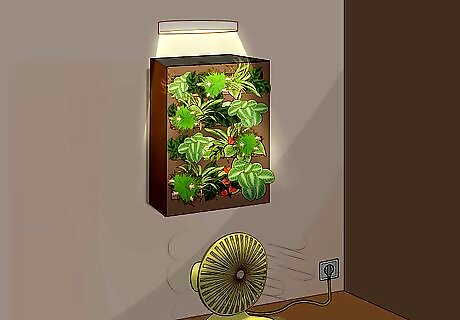
Add lighting to improve growing conditions for your wall. You may find, especially during certain times of the year, that your living wall does not receive the same amount of lighting it did when your wall was built and hung. You don't need to install recessed lighting, though, for your plants to flourish! A simple lamp equipped with a grow light can help your plants make it through the gloomier times of the year. Grow lights are specially designed light bulbs that emit a kind of light that encourages plants to photosynthesize. Normal household light bulbs will not stimulate photosynthesis in the same way.
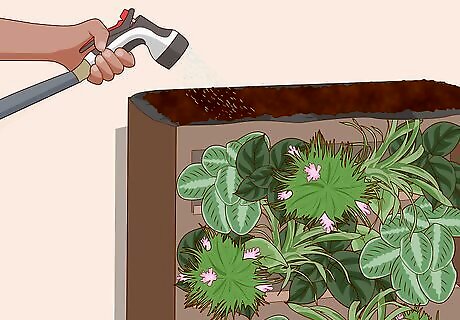
Water and fertilize your plants. How frequently you water and fertilize your plants will depend entirely on the kind of plants you have chosen to populate your living wall with. However, you should be aware that the resources normally available in nature won't be available to the plants in your living wall. Failing to water or fertilize can lead your plants to expire very quickly.



















Comments
0 comment